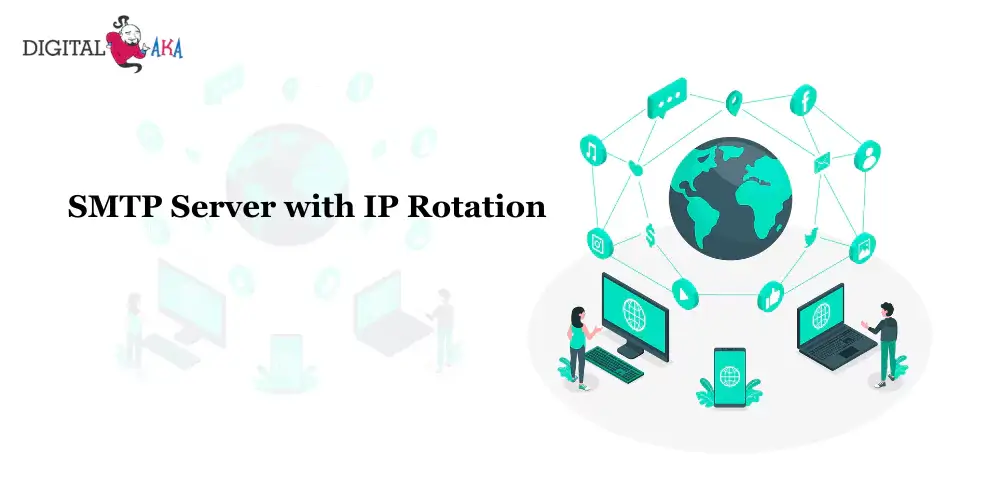
SMTP Server Provider in Mumbai- Essential Features
July 14, 2023
Email Blast Marketing Services Providers- Top 10 Platforms
July 31, 2023SMTP Server with IP Rotation: For businesses and organizations relying on email marketing campaigns, optimizing email deliverability and maintaining a positive sender reputation becomes even more important. One effective technique to achieve these goals is by utilizing an SMTP server with IP rotation.
Table of Contents
Pricing
| Trail Plan | Standard Plan | Premium Plan | Professional Plan |
| $50 | $145 | $185 | $225 |
| Sending Limit | Sending Limit | Sending Limit | Sending Limit |
| 1000 Emails/Hour | 1500 Emails/Hour | 3000 Emails/Hour | 5000 Emails/Hour |
What is an SMTP Server with IP Rotation?
What is IP Rotation in an SMTP Server?: SMTP servers with IP rotation are essential tools for managing email campaigns. An SMTP server is like a post office for emails, handling the delivery of messages from one server to another. IP rotation adds a layer of creativity by changing the sender’s IP address regularly.

This rotation helps avoid being flagged as spam by email providers and improves deliverability rates. it’s like sending emails from different post offices to prevent overcrowding and suspicion. SMTP servers with IP rotation are important for making sure your emails reach their destinations smoothly, maintaining your sender reputation, and boosting the success of your email campaigns.
Why is an SMTP Server with IP Rotation necessary?
Sending emails is an important part of communication for businesses, but sometimes emails get blocked or marked as spam. This happens when too many emails are sent from the same IP address, making it look suspicious to email providers.

IP rotation means using different IP addresses to send emails, spreading out the sending load. This helps avoid being flagged as spam and increases email deliverability.
Imagine you’re sending newsletters to your customers. With IP rotation, each newsletter goes out from a different IP address, making it less likely to trigger spam filters. It also allows for better management of email campaigns and helps maintain a good sender reputation.
The Role of SMTP Servers IP Rotation in Email Communication
IP rotation helps maintain email deliverability by avoiding blacklisting and improving email reputation. When an SMTP server sends emails from a single IP address regularly, it may trigger spam filters or get blacklisted if too many recipients mark emails as spam. By rotating IP addresses, the server can distribute outgoing emails across multiple addresses, reducing the risk of being flagged as spam.

Additionally, IP rotation can enhance email deliverability by overcoming limitations set by internet service providers on the number of emails sent from a single IP address within a specific timeframe. This strategy ensures smoother communication and higher chances of inbox placement for your emails.
They are intermediaries between your email client or application and the recipient’s email server. Once you hit the “Send” button, your email client communicates with the SMTP service provider Provide it with the necessary details like the sender’s and recipient’s addresses, subject line, and message content.
SMTP Server For Email Marketing also handles any necessary authentication, ensuring that the email is sent from a legitimate source. They verify the sender’s credentials and may implement additional security measures such as encryption to protect the email’s content during transit.
Do you know about the Best SMTP Server provider in Mumbai?
The Significance of IP Rotation in SMTP Servers
Maintaining a good sender reputation is vital for successful email delivery. Internet Service Providers (ISPs) and email service providers carefully evaluate the behavior and importance of SMTP servers. They assign sender scores based on email engagement, spam complaints, and bounce rates. A poor sender reputation can lead to emails being flagged as spam or blocked altogether.

This is where IP rotation comes into play. IP rotation involves periodically switching the IP address used by an SMTP server to send emails. Instead of relying on a single IP address, SMTP servers with IP rotation utilize a pool of IP addresses. With each email sent, the server randomly selects a different IP address from the pool, making it challenging for ISPs to associate a specific IP address with a particular sender.
Benefits of SMTP Servers with IP Rotation
Let’s now talk about the benefits of using SMTP Servers with IP rotation.

1. Enhanced Deliverability:
By rotating IP addresses, SMTP servers increase the chances of emails reaching recipients’ inboxes rather than getting lost in spam folders. This significantly improves email deliverability rates.
2. Maintained Sender Reputation:
IP rotation helps balance the sender’s reputation across multiple IP addresses. If one IP address encounters delivery issues or gets flagged, the other addresses can compensate, ensuring a stable overall reputation.
3. Higher Email Engagement:
By overcoming spam filters and being delivered to the primary inbox, emails sent from SMTP server providers with IP rotation are more likely to be opened, read, and engaged with by recipients. This can lead to higher open rates, click-through rates, and overall engagement metrics.
4. Reduced Blacklisting Risks:
When an SMTP server utilizes IP rotation, the risk of being blacklisted by ISPs or email security services decreases. By distributing email traffic across multiple IP addresses, the server avoids drawing undue attention and suspicion.
Implementing IP Rotation in SMTP Servers
To implement IP rotation effectively, consider the following steps:

1. Building a Diverse IP Pool:
Establish a pool of diverse and clean IP addresses from reputable sources. It’s crucial to ensure that the IP addresses have good sender reputations and are not associated with any previous spamming activities.
2. Configuring SMTP Server Software:
Configure the SMTP server software to handle IP rotation seamlessly. This may involve setting up a rotation schedule, determining the frequency of IP switches, and ensuring the server can handle the management of multiple IP addresses.
3. Monitoring Performance and Reputation:
Regularly monitor email delivery performance and sender reputation metrics. Keep an eye on bounce rates, spam complaints, and blacklisting status to identify any issues promptly.
4. Maintaining and Updating the IP Pool:
Continuously update and maintain the pool of IP addresses. Periodically check the reputation of the addresses and remove any that have experienced degradation or issues. Adding fresh, reputable IP addresses to the pool ensures a healthy rotation system.
Best Practices for Effective IP Rotation
To make the most of SMTP Server Providers with IP rotation, follow these best practices:

- IP Warm-up: When starting with a new IP address, gradually increase the volume of emails sent. This allows the server to build a positive reputation over time and establish trust with ISPs.
- Reputation Monitoring: Regularly monitor sender scores, bounce rates, and spam complaint rates to identify any potential reputation issues. Take corrective actions promptly to maintain a healthy sender reputation.
- Segmentation of Email Traffic: Divide your email campaigns across different IP addresses based on factors such as sender reputation, email content, and recipient engagement. This allows for better management and customization of each IP address’s reputation.
- Analysis of Delivery Performance: Monitor delivery rates, open rates, and engagement metrics to gauge the effectiveness of IP rotation and optimize email campaigns accordingly. This analysis helps in understanding the impact of IP rotation on campaign performance.
- Maintaining High-Quality Content: Ensure that your emails provide value to recipients and comply with anti-spam guidelines. By delivering relevant and engaging content, you increase the chances of positive user interactions.
Do you know about the Best SMTP server Provider in Kolkata?
Conclusion
Implementing an SMTP server with IP Rotation is a powerful technique for improving email deliverability and maintaining a positive sender reputation. By utilizing a pool of IP addresses and rotating them effectively, businesses and organizations can enhance their email marketing efforts, reach a larger audience, and achieve better overall campaign results.





